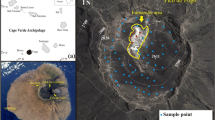Abstract
The concentration of H2 in soil gases has been measured weekly at five stations on the Atotsugawa and Ushikubi faults in northern central Main Island, Japan, since 1981 in search of possible relationship with earthquakes. The observed H2 concentration varies from lower than 1 ppm to 7.8% in time and place. When a large earthquake (M: 7.7, epicenter distance: 486 km) occurred on 26 May 1983, an outstanding discharge of H2 was observed at all five stations, preseismically at three of them, and coseismically at the other two. Simultaneous H2 emission was also observed at some stations in seven other occasions. These periods of unusual H2 discharge nearly coincided with occurrences of major earthquakes in Japan, but not of local minor earthquakes along the Atotsugawa fault. This fault, being a deep fracture zone, may be sensitive to large-scale crustal stress changes which incidentally cause the major earthquakes. Increased H2 may be produced by rock fracture caused by the increased stresses on the fault and by the earthquakes themselves. Local minor earthquakes along Atotsugawa fault with magnitude lower than 3 may be unable to cause sufficient rock fracture to produce significant H2.
Similar content being viewed by others
References
Irwin, W. P., andBarnes, I. (1980),Tectonic Relations of Carbon Dioxide Discharges and Earthquakes, J. Geophys. Res.85, 3115–3121.
King, C. (1980),Episodic Radon Changes in Subsurface Soil Gas Along Active Faults and Possible Relation to Earthquakes, J. Geophys. Res.85, 3065–3078.
Kita, I., Matsuo, S., andWakita, H. (1982),H 2 Generation by Reaction Between H 2 O and Crushed Rock: An Experimental Study on H 2 Degassing from the Active Fault Zone, J. Geophys. Res.87, 10789–10795.
Matsuda, T. (1966),Strike-slip Faulting Along the Atotsugawa Fault, Japan, Bull. Earthq. Res. Inst.44, 1179–1221.
Mavlyanov, G. A.,Geochemical Earthquake Prediction Studies in Central Asia (Academy Science Uz SSR, Tashkent 1977), 168 p.
Mikumo, T., andWada, H. (1983),The Atotsugawa Fault and its Seismicity, Chikyu5, 325–334.
Monakhov, F. I., Ashikhin, V. P., Bozhkova, L. I., Kissin, I. G., Khantaya, A. M., Shirokov, B. D., andShlyuyev, Yu. A. (1979),Short-term Hydrogeodynamic and Hydrogeochemical Forerunners of Earthquakes on Kunashir Island, Geokhimiya, 345–353.
Satake, H., andHayashi, Y. (1983),Consecutive Measurement of CO 2 and H 2 in Soil Gases at the Atotsugawa and Ushikubi Faults, Chikyu5, 366–372.
Shi, H., andCai, Z. (1979),A Preliminary Study on the Causes and Anomalous Phenomena of Subsurface Fluids Before Strong Shocks, K'o Hsueh T'ung Pao24, 1091–1094.
Sugisaki, R. (1978),Changing He/Ar and N 2 /Ar Ratios of Fault Air may be Earthquake Precursors, Nature275, 209–211.
Sugisaki, R., Anno, H., Adachi, M., andUi, H. (1980),Geochemical Features of Gases and Rocks Along Active Faults, Geochem. J.,14, 101–112.
Sugisaki, R., Ido, M., Takeda, H., Isobe, Y., Hayashi, Y., Nakamura, N., Satake, H., andMizutani, Y. (1983),Origin of Hydrogen and Carbon Dioxide in Fault Gases and its Relation to Fault Activity, J. Geol.91, 239–258.
Sugisaki, R., Ido, M., Takeda, H., Isobe, Y., Satake, H., Hayashi, Y., Nakamura, N., andMizutani, Y. (1984),Released Gases from Active Faults (2) Hydrogen-Chemical Features and Fault Activity-Zisin, 2nd ser.37, 55–65.
Takehana, Y., Kobayashi, Y., Wakita, H., andNakamura, Y. (1982),Emission of Hydrogen Along the Negoro Fault, Median Tectonic Line, Zisin, 2nd ser.35, 103–115.
Takemura, T. andFujii, S. (1984),Active Faults in the Northern Part of the Hilda Mountains, Central Japan, Quaternary Res.,22, 297–312.
Ui, H., andTakemura, Y. (1984),Rn Emanation at Atotsugawa Fault Accompanied with the Magnitude 7.7 Earthquake Occurred off Akita, Bull. Lab. Earthquake Chem. Tokyo Univ., No. 3, 57–59.
Wada, H., Mikumo, T., andKoizumi, M. (1979).Seismicity and Focal Mechanism of Local Earthquakes Along the Atotsugawa Fault and in the Northern Hida Region, Zisin 2nd ser.32, 281–296.
Wakita, H., Fujii, Y., Matsuo, S., Notsu, K., Nagao, K., andTakaoka, N. (1978),Helium Spots: Caused by a Diapiric Magma from the Upper Mantle, Science200, 430–432.
Wakita, H., Nakamura, Y., Kita, I., Fujii, N., andNotsu, K. (1980),Hydrogen Release: New Indicator of Fault Activity, Science,210, 188–190.
Author information
Authors and Affiliations
Rights and permissions
About this article
Cite this article
Satake, H., Ohashi, M. & Hayashi, Y. Discharge of H2 from the Atotsugawa and Ushikubi Faults, Japan, and its relation to earthquakes. PAGEOPH 122, 185–193 (1984). https://doi.org/10.1007/BF00874592
Issue Date:
DOI: https://doi.org/10.1007/BF00874592




